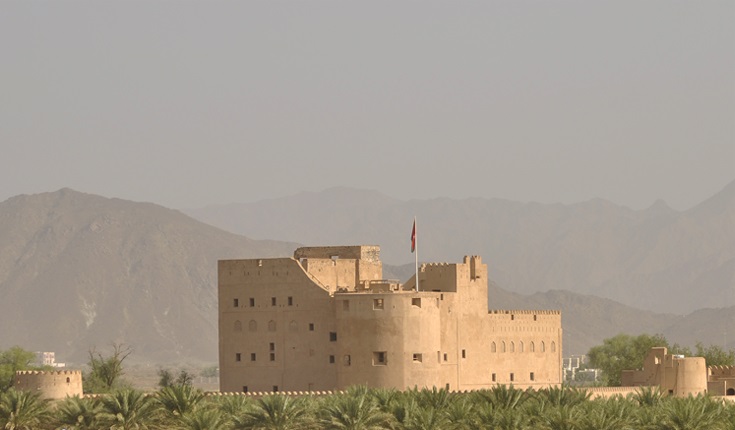Nizwa

Nizwa
The Wilayat of Nizwa's ancient city streets and buildings filled with the ghosts of the past contrast with the pretty terraced mountain villages, thickets, orchards and aflaj of its niya-bat of the Jabal al Akhdhar. Nizwa is the capital of the Dakhiliyah and its busy souq, which serves people from all over the region, is both a tourist attraction and a commercial centre.
The Wilayat of Nizwa borders on the wilayats of Adam, Manah and lzki to the south and east and al Hamra and Bahla to the west. From the north it is overlooked by the mountain peaks of the Jabal al Akhdhar. It is 170 Kilometres from the Governo ate of Muscat.Its main features are its huge fort (known as al Shahba'}.
The design of the renovated old souq blends in harmoniously with the Friday mosque and the fort. The wilayat has a large number of villages as well as two niyabats - Birkat al Mawz and the Jabal al Akhdhar. The Niyabat of Birkat al Mawz is renowned for its fine old buildings and the village is typical of an Omani village at its prettiest and most charming. The recently restored two-storied fort of Bait al Radaidah, which dates from the 17th century AD, is in Birkat al Mawz. There are turrets set within its thick mud outer walls, while its interior contains numerous arches and its walls and ceilings are coated with elegantly patterned gypsum. The old mosque near the fort, which dates from the same period, was also restored recently.
Visitors to the Niyabat of Birkat al Mawz can enjoy a stroll through the alleyways of its old residential quarter with its mud and gypsum houses. The fast-flowing Falaj al Khatmain is a falaj of the ghaili type (i.e. a mainly seasonal falaj which draws its water from the wadi channels or mountains) which has its source on the slopes of the Jabal al Akhdhar, then flows through irrigation channels around the village before ending up again very near its source.
The stunningly beautiful Niyabat of the Jabal al Akhdhar is at its best when its roses,myrtles, saffron, narcissi and other fragrant trees and plants are in flower and when the trees in its orchards are heavy with ripe apricots, peaches, pomegranates, walnuts, almonds, figs, pears, plums, sweet oranges and other fruits.Bait Sulait in the city of Nizwa is a fort of major historical importance near Falaj Daris. Originally a three-storied building with a solid defensive wall and two towers, it is surrounded on all sides by palm groves, though little remains of it today apart from a few ruins Afhe gardens, orchards and fertile villages are fed by numerous aflaj including Falaj Daris - one of the biggest aflaj in the Dakhiliyah Governorate. A delightful park has been established at the head of the falaj. Some of the other aflaj include al Ghantaq, Dhawt, Tanuf - a popular picnic spot during the rainy season when the water from its channels becomes a waterfall - Sa'al, al Ain and Riddat Albusaid.
The Wilayat of Nizwa is criss-crossed by scenic wadis, including Wadi Tanuf, which skirts the old town of Tanuf; a groundwater recharge dam was built across its course in 1989. Another dam was built across Wadi al Mu'aidin in 2002. Other wadis that feed the wilayat's aflaj include Wadi al Abyadh and Wadi Kalbuh.
Traditional Occupations
Agriculture is the most common occupation in the Dakhiliyah Governorate, which is also renowned for its traditional handicrafts such as Omani khanjars, gold and silver jewellery, spinning, weaving, copper ware, palm leaf products, leather work, metalwork, rose water and other local products.


